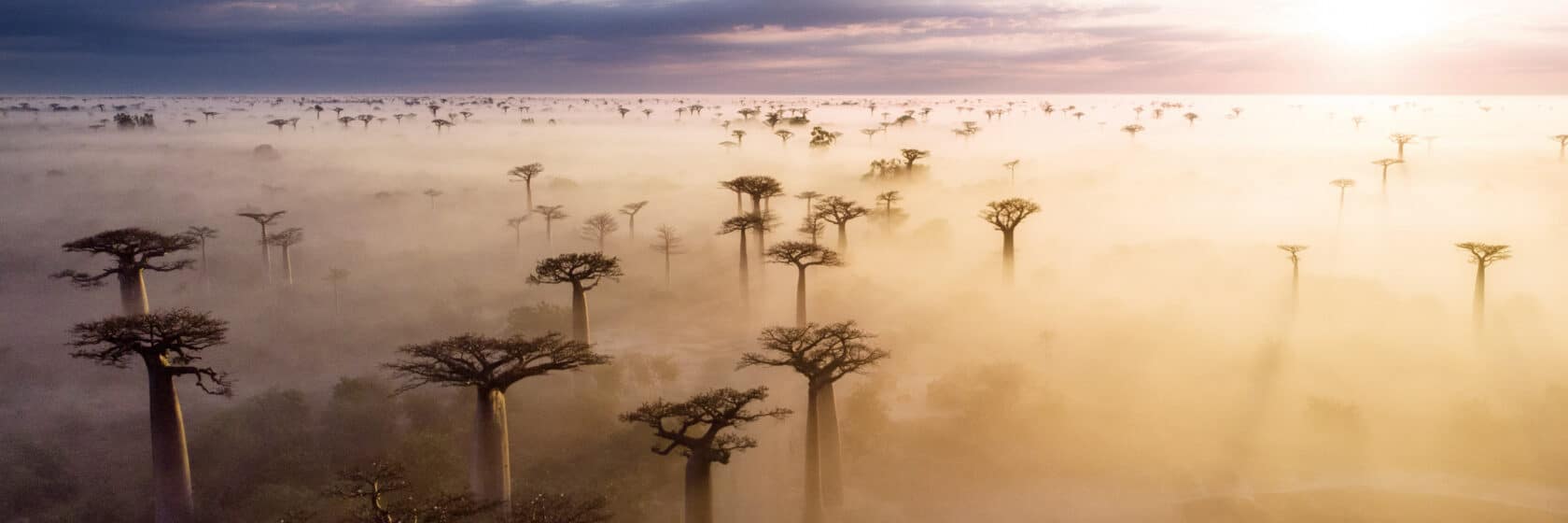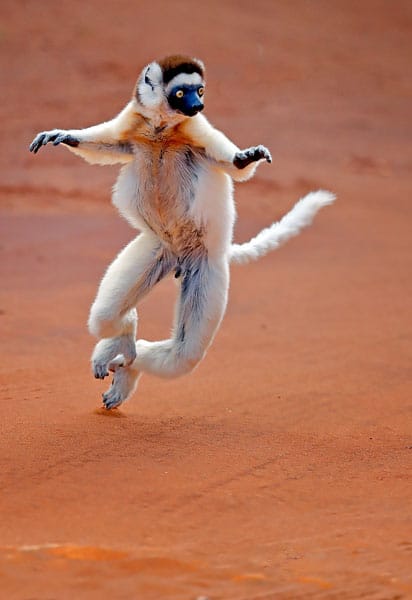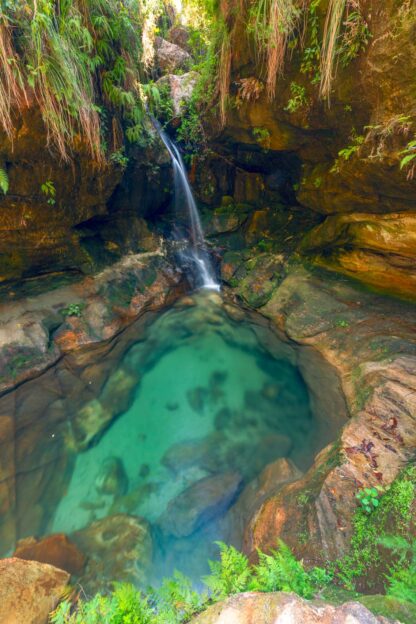
Madagascar
Madagascar’s Best National Parks

We Share the Best of Madagascar’s Spectacular Parks
From lush, green rainforests to stark limestone tsingy formations to the dry spiny desert, Madagascar has a huge range of ecosystems, geography, and microclimates—and every area supports its own endemic species. Berenty, in the south, is the best place to see dancing sifaka lemurs, while Ankarana, in the north, is home to crowned lemurs. The golden bamboo lemur is endemic to Ranomafana in the southeast, and Zombitse is the only place on earth to see Hubbard’s sportive lemurs and Appert’s greenbul (a pretty little pink-billed warbler) in the wild.
Wilderness Travel has carefully crafted each itinerary so you can see a wide variety of plants and animals. Here’s what to expect in some of the major parks and reserves:


Andasibe National Park (Formerly Perinet) & Lemur Island
A land known by many names, Andasibe National Park is comprised of Anamalazaotra Reserve and Mantadia National Park. Their montane forest is home to the famous “singing” indri lemur (nearly 300 live here) and the Parson’s chameleon, the largest and perhaps most impressive of their respective species. The park also teems with a vibrant collection of butterflies, birds, orchids, and ferns. We almost always see common brown lemurs, grey bamboo lemurs, eastern bamboo lemurs, and woolly lemurs, as well as several species of the nocturnal tenrec, an insectivorous mammal resembling a hedgehog. We may also see black-and-white ruffed lemurs, diademed sifaka, and red-bellied lemurs. During our easy walks we’ll become familiar with the special flora and fauna of Madagascar’s eastern rainforests, and because we’re here for several days, we’ll have the opportunity to take a night hike for a glimpse into the fantastic nocturnal world of Madagascar’s forests.
We also visit with the friendly lemurs at Lemur Island, a small island that is home to orphaned lemurs who would not have survived on their own. Because they’re cared for by rangers, the brown lemurs, bamboo lemurs, and black-and-white ruffed lemurs that live here are habituated to humans, allowing close encounters and excellent photo opportunities. The friendly inhabitants might even jump onto your shoulder and offer a “lemur massage” with their soft little paws.
Special Features
- Excellent place to see singing indri and colorful Parson’s chameleon
- Included on Madagascar: Off the Beaten Path, Magical Madagascar, and Madagascar Private Journey itineraries
- Known as the world’s capital of frogs, with more than 100 species
- Look for common brown lemurs, grey bamboo lemurs, eastern bamboo lemurs, woolly lemurs, black-and-white ruffed lemurs, diademed sifaka, red-bellied lemurs
Flora and Fauna
- Excellent place to see singing indri and colorful Parson’s chameleon
- Known as the world’s capital of frogs, with more than 100 species
- Look for common brown lemurs, grey bamboo lemurs, eastern bamboo lemurs, woolly lemurs, black-and-white ruffed lemurs, diademed sifaka, red-bellied lemurs


Berenty Reserve
A small private park that preserves a third of Madagascar’s remaining tamarind forest, Berenty is a superb place to see a variety of wildlife. Be ready for surprise encounters with beautiful sifaka lemurs as they “dance” across our path. We’ll also see ring-tailed lemurs (they’re everywhere!) and red-fronted brown lemurs during the day. And since they’ve been habituated for 70 years, it’s easy to get spectacular photographs—sifaka come right into the front of our lodge, dancing on the breakfast terrace! This is also an especially good place to photograph lemurs dancing in the forest, because there are wide open spaces between the trees—unlike other parks where the trees are closer together and the sifakas prefer to jump from tree to tree. (The IMAX film Island of Lemurs includes scenes of Berenty’s dancing sifakas.)
We enjoy two full days in this remarkable reserve, with easy walks along well-maintained paths, and optional early morning birding walks or walks paced for avid photographers. The bird life here includes grey-headed lovebirds, vasa parrots, crested and giant couas, Madagascar bulbuls, paradise flycatchers, Madagascar white-eyes, Madagascar cuckoo shrikes, and the bright red and yellow sparrow-like fodys. We’ll also watch for roosting Madagascar fruit bats, flying foxes, huge multi-colored chameleons, and radiated tortoises.
One evening there may be a local dance performance and another evening we can set out on a night walk. We often see the grey-brown mouse lemur and the white-footed sportive lemur during our night walks.
Special Features
- In the southeastern part of Madagascar
- Included on our Magical Madagascar itinerary
- Easy walks (flat and shady) in two ecosystems: tropical dry forest and spiny forest
- Cultural components include a museum, burial ground, dance performance
- Best night hikes in Madagascar
Flora and Fauna
- Good for photography: home to six species of lemur and more than 100 bird species
- Best place to see Verreaux’s sifakas; the IMAX film of “dancing” sifakas was shot here
- Watch for ring-tailed lemurs, brown lemurs, red-fronted brown lemurs, native radiated tortoises, fruit bats, flying foxes
- Excellent place to see chameleons, including the colorful panther chameleon
- Baobabs nearby


Ankarana National Park
Ankarana showcases some of Madagascar’s most spectacular landscapes, with unique eroded limestone towers known as tsingy. We should see many crowned lemurs (the reserve harbors one of the largest and least disturbed populations of this distinctive primate) and Sanford’s brown lemurs, as well as the inquisitive ring-tailed mongoose, cat-like fossa, tenrecs, and Madagascar civet. Bird-watching is excellent here too: seeing a mixed-species flock of passerines moving slowly by as they forage is unforgettable. Ankarana is also outstanding for reptiles, with 50 species including panther chameleons, some endemic and threatened snakes and geckos, and 10 species of frogs. Hikes range from easy to moderate, with some challenging options available.
Special Features
- In the northern part of Madagascar
- Included on both Magical Madagascar and Ankarana Extension itineraries
- A favorite park for hikers
Flora and Fauna
- Watch for northern Madagascar’s Sanford’s lemurs, crowned lemurs, ands dwarf lemurs in the dry deciduous forest
- Good place to see spectacular tsingy formations and baobabs
- Great views of chameleons and other reptiles; nearly 100 bird species


Isalo National Park
One hundred fifty million years of elemental exposure have shaped Isalo’s barren sandstone landscape into an ideal hiking location punctuated with natural pools, surreal ridges, impressive gorges and canyons, and stalagmite pinnacles. We can enjoy an optional challenging hike to the Cascade des Nymphes, where a spectacular hidden waterfall cascades into an emerald-green pool. The park shelters endemic plants, ring-tailed, red-fronted brown, and Verreaux’s sifaka lemurs, as well as sacred Bara burial sites in the high cliffs. We can learn more about geology, plants, and local culture at the museum here. In the evening, we watch the sun set behind a photogenic natural rock formation known as the Window of Isalo.
Special Features
- In the southern part of Madagascar—spiny and deciduous forests, rocky canyons
- Included in our Madagascar: Off the Beaten Path itinerary
- Hotel has a pool and spa; hike to hidden waterfall and beautiful swimming spot
- Isalo Museum (geology, plant life, culture)
Flora and Fauna
- Dry, deciduous forest: watch for ring-tailed lemurs, red-fronted brown lemurs, Verreaux’s sifaka; also panther chameleons and others
- Nearly 80 species of birds, including the rare and colorful Benson’s rock-thrush
- Rare palms and aloe specie

Anja Community Reserve
Anja Reserve is a community initiative run by several local villages, providing employment and income for local community members. The reserve’s focus on conservation and education have contributed to the rebound of the area’s once-dwindling population of ring-tailed lemurs—today, nearly 500 thrive here. We have an easy walk on a flat trail with rock outcroppings where we can get a good look at their fascinating behavior. The males communicate through scent-marking, smearing scent on their tails and wafting the scent towards their opponents by waving their tails at each other in “stink fights.” They also like to sunbathe and lick rocks for their mineral content. We’ll have excellent photo opportunities here, and can also get a good look at many species of chameleons, including the beautiful, brightly colored panther chameleons.
Special Features
- In the southern part of Madagascar
- Included in our Madagascar: Off the Beaten Path itinerary
- Unique environmental and cultural preservation site where humans and wildlife flourish together
Flora and Fauna
- Largest population of ring-tailed lemurs in the world—more than 300 live here
- Good photo ops for panther chameleons and ring-tailed lemurs
- Diverse plant life includes species from the spiny desert, central highlands, and dry forests. Many endemics have medicinal properties.


Kirindy Forest
Kirindy’s threatened dry deciduous forest ecosystem is a habitat for red-fronted brown lemurs, common brown lemurs, Verreaux’s sifaka lemur and several endemic chameleons; it is also the most likely place to see Madagascar’s largest predator, the elusive fossa—especially during mating season from October to December. This cat-like carnivore, a member of the mongoose family, has been compared to a small cougar and feeds mostly on…lemurs.
Special Features
- In the western part of Madagascar
- Included in our Madagascar: Off the Beaten Path itinerary
- Flat, easy trails
Flora and Fauna
- Best place to see fossa
- Good for chameleons and birding
- Huge baobabs


Ranomafana National Park
This lush rainforest is home to many species of lemurs, including the rare and critically-endangered golden bamboo lemur, which was discovered here by renowned primatologist Dr. Patricia Wright. We’ll see geckos, chameleons, and a multitude of bird species—maybe even the slender-billed flufftail, once believed extinct but re-discovered here in the park, and considered by some to be the holy grail of Madagascar birding. The terrain is sometimes steep and the trails can be slippery, but the rewards of seeing exotic wildlife make it worth the effort. We offer guided options each day for easier, slower hikes (ideal for photographers), more challenging hikes, early morning birding excursions, or birdwatching on your own from the ValBio Center. There is also a botanical garden in Ranomafana—with lots of chameloens—for those who want to take it easy.
Special Features
- In the southeastern part of Madagascar
- Included in our Madagascar: Off the Beaten Path itinerary
- Hikes here are moderate to difficult
- We enjoy a private talk with a wildlife researcher and a lecture at ValBio Center
Flora and Fauna
- Watch for greater bamboo lemur, eastern bamboo lemur, golden bamboo lemur, red-bellied lemur, Milne-Edwards’ sifaka, black-and-white ruffed lemur, red-fronted brown lemur; 115 species of birds (30 are endemic) including the scaly ground-roller, slender-billed flufftail; geckos, many chameleons
- Botanical garden with chameleons

Zombitse-Vohibasia National Park
One of Madagascar’s more obscure parks, Zombitse-Vohibasia is in a transition zone between Madagascar’s dry and humid forests; as a result, it has a high level of biodiversity. The endangered Hubbard’s sportive lemurs are found only in this park, and Verreaux’s sifaka, red-fronted brown lemurs, ring-tailed lemurs, white-footed sportive lemurs live here too. We may also see the 11-inch Standing’s day gecko, which, depending on the light, may be bright green or turquoise with blue reticulated markings. Baobabs and several orchids are common, and 85 species of birds live here. Zombitse-Vohibasia is the only place on the planet to spot the rare, endemic Appert’s greenbul, a pretty little warbler with a pink bill and yellow belly.
Special Features
- In the southwestern part of Madagascar
- Included in our Madagascar: Off the Beaten Path itinerary
- Easy hikes
Flora and Fauna
- The only place in the world to see Appert’s greenbul
- We almost always see a huge Furcifer chameleon here
- 2nd largest population of sifaka lemurs
- Watch for Verreaux’s sifaka (maybe in a group), red-fronted brown lemurs, ring-tailed, white-footed sportive, Hubbard’s sportive lemur; Standing’s day gecko; chameleons


Amber Mountain National Park
An oasis in the north, Amber Mountain sets itself apart from its surroundings with its own unique microclimate. Cool, fresh air and lush tropical grounds gilded with huge green tree ferns, waterfalls, and crystal-clear volcanic lakes make it no wonder this was Madagascar’s inaugural national park.
Here we’ll find a wealth of wildlife, including the world’s smallest chameleon (it’s the size of a fingernail), 35 endemic species of birds, and other species not found in the south of Madagascar. Crowned lemurs and Sanford’s brown lemurs are at Amber Mountain, and this is one of the best places to see Madagascar’s amazing chameleons, including the Amber Mountain chameleon (endemic to the park), blue-nosed chameleon, globe-horned chameleon, Parson’s chameleon, and tiny dwarf chameleon and stump-tailed chameleon. There are 60 reptile species in the park, including leaf-tailed geckos, 35 frog species, and more than 40 butterfly species. The quantity and variety of species we see here are astounding.
Special Features
- In the northern part of Madagascar
- Included on both Magical Madagascar and Ankarana Extension itineraries
- Lush grounds with waterfalls
Flora and Fauna
- Watch for Sanford’s lemurs and crowned lemurs
- One of the best places to see chameleons
Learn More
Talk to an Expert
Our Africa Specialists know every detail about our Madagascar trips. They will be happy to answer any questions and help you choose the journey that’s right for you. Contact us to learn more or book your trip today!




